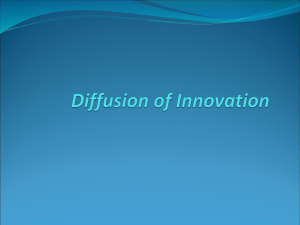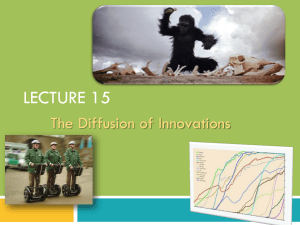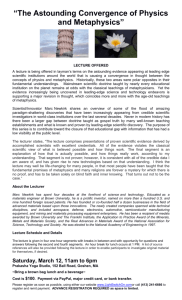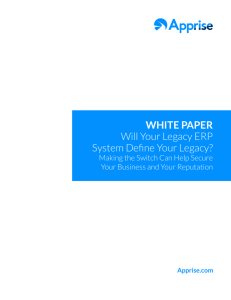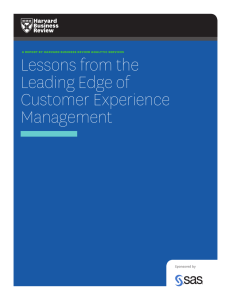HOW DO `LEADING-EDGE` OPINION LEADERS BRIDGE THE
advertisement
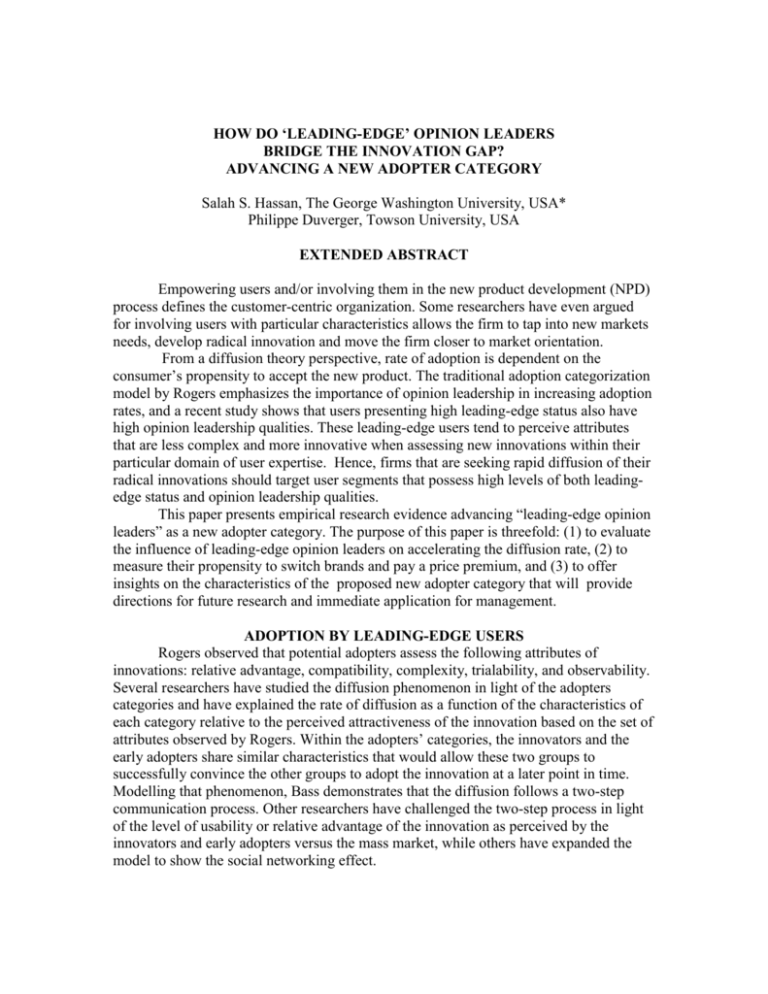
HOW DO ‘LEADING-EDGE’ OPINION LEADERS BRIDGE THE INNOVATION GAP? ADVANCING A NEW ADOPTER CATEGORY Salah S. Hassan, The George Washington University, USA* Philippe Duverger, Towson University, USA EXTENDED ABSTRACT Empowering users and/or involving them in the new product development (NPD) process defines the customer-centric organization. Some researchers have even argued for involving users with particular characteristics allows the firm to tap into new markets needs, develop radical innovation and move the firm closer to market orientation. From a diffusion theory perspective, rate of adoption is dependent on the consumer’s propensity to accept the new product. The traditional adoption categorization model by Rogers emphasizes the importance of opinion leadership in increasing adoption rates, and a recent study shows that users presenting high leading-edge status also have high opinion leadership qualities. These leading-edge users tend to perceive attributes that are less complex and more innovative when assessing new innovations within their particular domain of user expertise. Hence, firms that are seeking rapid diffusion of their radical innovations should target user segments that possess high levels of both leadingedge status and opinion leadership qualities. This paper presents empirical research evidence advancing “leading-edge opinion leaders” as a new adopter category. The purpose of this paper is threefold: (1) to evaluate the influence of leading-edge opinion leaders on accelerating the diffusion rate, (2) to measure their propensity to switch brands and pay a price premium, and (3) to offer insights on the characteristics of the proposed new adopter category that will provide directions for future research and immediate application for management. ADOPTION BY LEADING-EDGE USERS Rogers observed that potential adopters assess the following attributes of innovations: relative advantage, compatibility, complexity, trialability, and observability. Several researchers have studied the diffusion phenomenon in light of the adopters categories and have explained the rate of diffusion as a function of the characteristics of each category relative to the perceived attractiveness of the innovation based on the set of attributes observed by Rogers. Within the adopters’ categories, the innovators and the early adopters share similar characteristics that would allow these two groups to successfully convince the other groups to adopt the innovation at a later point in time. Modelling that phenomenon, Bass demonstrates that the diffusion follows a two-step communication process. Other researchers have challenged the two-step process in light of the level of usability or relative advantage of the innovation as perceived by the innovators and early adopters versus the mass market, while others have expanded the model to show the social networking effect. Opinion leadership is a defining characteristic of the opinion leader. It is also a strong characteristic of the early adopter. Therefore, it explains the high personal communication effort (WOM and eWOM/ “Word of Mouse”) used by the opinion leader to influence the behavior of other people in terms of search, purchasing and usage of new products. Generally, the communication mode of the opinion leaders is informal; however, they play a major role in influencing the consumer decision-making process as they represent a reliable source of information. As a result, marketers work to create communication channels to reach opinion leaders in order to encourage them to spread positive word of mouth. Accordingly, this research identifies three types of users: 1) Leading-edge users with high levels of opinion leadership, from here on called “leading-edge opinion leaders”; 2) Leading-edge users with low levels of opinion leadership, now referred to as “leading-edge users”; and 3) consumers with low level of leading-edge status and opinion leadership referred to as “the Mass consumers”. At the aggregate level, it is proposed that the behavior of a new adopter category possessing lead-user characteristics and opinion leadership attributes will accelerate the rate of innovation diffusion. METHODS AND RESULTS This study evaluated the perception and adoption intentions of leading-edge users when confronted with a choice between a current new product, and a radical new innovation. Our first task was to develop a radical new innovation that would be believable to the participants. In the first stage, we extracted leading-edge users’ ideas on innovative laptop features using an electronic ideation process (244 respondents to an electronic survey, from which 58 ideas were extracted from 52 participants). The ideas were then ranked using the Amabile consensus assessment technique (CAT) where higher scores define the most creative ideas as assessed by the expert panel composed of 11 people averaging 9.6 year of experience in the technology field. Using a stepwise regression with the idea scores as dependant variables and the characteristics of the respondents as independent variables (participants’ characteristics construct measures were taken from the existing literature and confirmatory factor analyses led to satisfactory goodness-of-fit measures greater than 0.95 and alpha coefficients greater than 0.70) led to a good fit of the model (Global F p-value < 0.0001) and significant parameter estimates for the leading-edge user and opinion leader characteristics (both p<0.0001). Out of the 76 ideas extracted from the toolkit participants 34 of the most creative ideas (ideas above the mean of 164.45) were selected for the second stage of our analysis. The adoption of innovation construct was measured using two manifest variables: the intent to purchase the idea if it was available on the market (a 5 point-likert scale was used) and the intent to speak (WOM) to a friend, family or colleague about the idea. Using a latent score method, an analysis of the interaction effect between the underlying characteristics: leading-edge status and opinion leadership as they relate to the adoption of radical innovation construct was conducted. This research demonstrates that leading-edge users have a critical role in the diffusion of radical product. Beyond the widely accepted adopter categories, a new hybrid category named: “Leading-edge Opinion Leaders” can be seen as emerging from the known innovators and early adopters categories. They will help diffuse the radical new product by adopting it, propagating it to others, and will pay a price premium to acquire it. Managerial implications of this research relate directly to the possibility of an extension of the traditional adoption categories. REFERENCES Amabile, T. M. (1982). Children’s artistic creativity: detrimental effects of competition in a field setting. Personality and Social Psychology Bulletin, 8: 573-578. Amabile, T.M. (1996). Creativity in Context. Boulder, Colorado: Westview Press. Bass, F. M. (1969). A new product growth for model consumer durables. Management Science, 15 (5): 215-227. Bower, J. L and Christensen, C.M. (1995). Disruptive Technologies: catching the wave. Harvard Business Review, 73: 43-53. Franke, N. and Piller, F. (2004). Toolkits for User Innovation and Design: an exploration of user interaction and value creation. Journal of Product Innovation Management, 21: 401-415. Franke, N. and Shah, S. (2003). How communities Support Innovative Activities: An exploration of assistance and sharing among End-Users. Research Policy, 32(1): 157-178. Franke, N, von Hippel, E., and Schreier, M. (2006). Finding Commercially Attractive User Innovations: A Test of Lead-User Theory, Journal of Product Innovation Management, 23(4)301-315. Goldsmith, R. E., and Witt, T. S. (2005) “The Predictive Validity of an Opinion Leadership Scale” Journal of Marketing Theory and Practice (Winter), 28-35. Gupta, A. K. and Rogers, E. M. (1991) “ Internal Marketing: Integrating R&D and Marketing Within the Organization” The Journal of Service Marketing 5(2), 5568. Hassan, Salah S. (2008). “Harnessing Lead-User Innovation: From Collaborative User Communities to Mass Market,” HBS-MIT User and Open Innovation Workshop, Harvard Business School, Boston, Massachusetts, August, 2008. Hauser, J.; Tellis, G. J. and Griffin, A. (2006). Research on Innovation: A Review and Agenda for Marketing Science. Marketing science 25(6 ):687-732. Keller, K.L. (2003). Strategic Branding Management: building, measuring, and managing brand equity. NJ: PrenticeHall (2nd Ed.). Keller, K.L.; and Lehmann, D.R. (2002). The brand value chain: linking strategic and financial brand performance, Tuck School of Business, Dartmouth College working paper. Kirca, A.H., Jayachandran, S., and Bearden, W.O. (2005). Market orientation: A metaanalytic review and assessment of its antecedents and impact on performance. Journal of Marketing, 69:24-41. Lüthje, C. and Herstatt, C. (2004), “The Lead User Method: An Outline of Empirical Findings and Issues for Future Research”, R&D Management, 35(5), 553-568. Lyons, B. and Henderson, K. (2005) “Opinion leadership in a computer-mediated environment” Journal of Consumer Behaviour 4(5), 319-329. March, A. (1994), “Usability: The New Dimension of Product Design”, Harvard Business Review, 72(5), 144-149. Morrison, P. D.; Roberts, J. H.; von Hippel, E. (2000) “Determinants of User Innovation and Innovation Sharing in a Local Market”, Management Science, 46(12), 15131527. Myers, J. H. and Robertson, T. S. (1972) “Dimensions of Opinion Leadership” Journal of Marketing Research, 4 (February), 41-46. Piller, F. T. and Walcher, D. (2006) “Toolkits for Idea Competitions: A Novel Method to Integrate Users in New Product Development” R&D Management 36(3), 307318. Rogers, E.M. (2003), Diffusion of Innovations, (5th ed.) New York: The Free Press. Shah, D., Rust, R.T., Parasuraman, A., Staelin, R., and Day, G.S. (2006). The path to customer centrality, Journal of Service Research, 9(2):113-124. Schreier, M.; Oberhauser, S.; and Prügl, R. (2007), “Lead Users and the Adoption and Diffusion of New Products: Insights from Two Extreme Sports Communities” Marketing Letters, 18 (1-2), 15-30. Schumaker, R. E., and Lomax, R. B. (1996). A beginner’s guide to structural equation modeling. Hillsdale, NJ: Erlbaum. Slater, F.S., and Naver, J.C. (1998). Customer-led and market-oriented: Let’s not confuse the two. Strategic Management Journal, 19(10):1001-1006. Urban, G. L., and von Hippel, E. (1988), “Lead User Analyses for the Development of New Industrial Products”. Management Science, 34(5), 569-582. Van den Bulte, C., and Lilien, G.L. (2001). Medical Innovation Revisited: Social Contagion versus Marketing Effort. American Journal of Sociology, 106( 5): 1409-1435. von Hippel, E. (2005). Democratizing Innovation. The MIT Press, USA. von Hippel, E. (1986). “Lead Users: A Source of Novel Product Concepts”, Management Science 32(7), 791-805 Walker, G. 1985. Network position and cognition in a computer firm. Administrative Science Quarterly, 30: 103-130. * Lead author’s contact address: Hassan@gwu.edu

